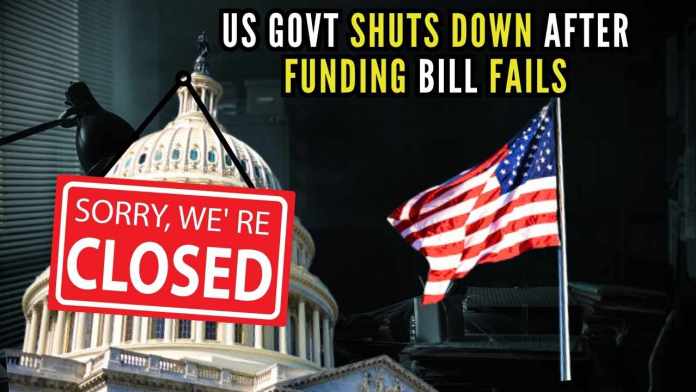
US faces first shutdown in 7 years
The US government has officially shut down for the first time in nearly seven years after lawmakers failed to reach a deal on a temporary funding bill. The shutdown began at midnight after Senate Democrats blocked a Republican-backed stopgap measure that excluded key Democratic priorities, most notably the extension of expiring health care subsidies.
The deadlock has thrown federal operations into disarray. As of now, no clear path forward has emerged from Capitol Hill.
The last government shutdown occurred during President Donald Trump’s first term, lasting five weeks from late 2018 into early 2019. This new shutdown is projected to be even more disruptive, with analysts warning of widespread economic and social consequences if the impasse drags on.
Federal services frozen, workers furloughed
The shutdown means hundreds of thousands of federal employees will be affected. As many as 7,50,000 workers could be temporarily furloughed, according to estimates by the nonpartisan Congressional Budget Office. “Non-essential” employees will be placed on unpaid leave, while “essential” workers—such as military personnel, air traffic controllers, and border agents—must continue working without pay.
Key government functions, such as national security, in-hospital medical care, law enforcement, and air traffic control, will continue, but others will grind to a halt. National parks may close, student loan services could pause, and food safety inspections may be disrupted. Federally funded programs, such as Head Start and food assistance, may also face cuts or closures.
While Social Security and Medicare checks will still be distributed, services such as benefits verification and new card issuance could be delayed.
Economic and political fallout
Economists warn that each week of the shutdown could shave between 0.1 and 0.2 percentage points off US GDP growth. While immediate effects may be muted, a prolonged shutdown risks weakening consumer confidence, disrupting markets, and slowing economic momentum.
The current political standoff has highlighted the deepening dysfunction in Washington. Democrats are demanding that any spending bill include an extension of Affordable Care Act subsidies, set to expire at year’s end. Without them, health care costs could spike for more than 24 million Americans—particularly in Republican-led states like Florida and Texas that have declined to expand Medicaid.
Republicans argue that the issues should be separated and accuse Democrats of using the budget as a bargaining chip ahead of the 2026 midterms. They remain opposed to bundling long-term health care reforms into a short-term funding measure.
Trump escalates tensions
President Trump has intensified the political brinkmanship, threatening mass layoffs of federal workers and vowing to cut programs favored by Democrats. On Tuesday, he told reporters, “We’ll be laying off a lot of people. They’re going to be Democrats.”
Such comments have raised alarm among federal worker unions and watchdog groups. This week also marks a significant exodus from the federal workforce, with over 150,000 employees taking early retirement buyouts—the largest departure in 80 years.
Trump’s refusal to release previously approved funds has further inflamed tensions, leading some Democrats to question why they should support any future appropriations bills.
Uncertain path ahead
This marks the 16th government shutdown since 1981. Most have lasted only a few days, but the last one stretched to 35 days. With both parties firmly entrenched in their positions, it is unclear how long the current closure will persist.
Unless a compromise is reached soon, the consequences could be severe—not just for federal employees and government operations, but for millions of Americans who rely on federal programs and services every day.
For all the latest updates, download PGurus App.
- Radical Islamists torch Hindu home in Bangladesh, issue ‘final warning’ to community - December 23, 2025
- Trump cites India-Pakistan de-escalation while flagging Ukraine impasse - December 23, 2025
- From Berlin, Rahul Gandhi alleges ‘institutional capture’; BJP accuses him of defaming India abroad - December 23, 2025











Make America Great Again !! Time & permissions to print more US $ $ $ notes / bills Good times are back.